Nordossetien–Alanien |
|
|
|
| Übersicht – Contents: | |
Diese Seite ist Teil des Projektes
Nordossetien–Alanien |
|
|
|
| Übersicht – Contents: | |
Flagge – Flag: |
|
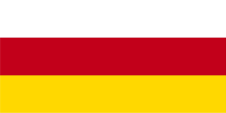 |
seit/since 1994, |
|
|
|
historische Flaggen – historical Flags: |
|
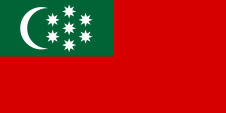 |
1921–1924, Flagge Autonome Sowjetische Bergrepublik (Gebirgsrepublik) – flag of the Autonomous Soviet Mountain Republic, Seitenverhältnis – ratio = 1:2, Quelle/Source, nach/by: Wikipedia (DE) |
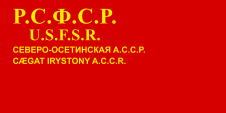 |
1937–1938, Flagge der Autonomen Sowjetrepublik – flag of the autonomous soviet republic, Seitenverhältnis – ratio = 1:2, Quelle/Source, nach/by: World Statesmen |
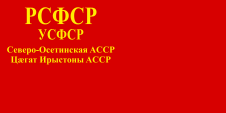 |
1938–1954, Flagge der Autonomen Sowjetrepublik – flag of the autonomous soviet republic, Seitenverhältnis – ratio = 1:2, Quelle/Source, nach/by: World Statesmen |
 |
1942–1945, Flagge Nordkaukasische und Gebirgs-Kaukasische Legion in der Deutschen Wehrmacht – flag of the North Caucasian and Mountain Caucasian Legion in the German Wehrmacht, Seitenverhältnis – ratio = 1:2, Quelle/Source nach/by: Wikipedia (EN) |
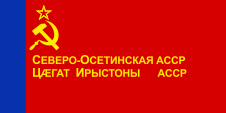 |
1954–1956, Flagge der Autonomen Sowjetrepublik – flag of the autonomous soviet republic, Seitenverhältnis – ratio = 1:2, Quelle/Source, nach/by: World Statesmen |
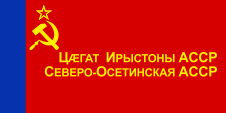 |
1956–1978, Flagge der Autonomen Sowjetrepublik – flag of the autonomous soviet republic, Seitenverhältnis – ratio = 1:2, Quelle/Source, nach/by: World Statesmen |
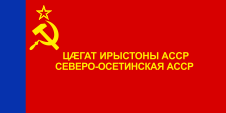 |
1978–1981, Flagge der Autonomen Sowjetrepublik – flag of the autonomous soviet republic, Seitenverhältnis – ratio = 1:2, Quelle/Source, nach/by: World Statesmen |
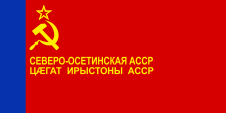 |
1981–1991, Flagge der Autonomen Sowjetrepublik – flag of the autonomous soviet republic, Seitenverhältnis – ratio = 1:2, Quelle/Source, nach/by: World Statesmen |
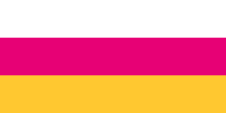 |
1991–1994, Nationalflagge – national flag, Seitenverhältnis – ratio = 1:2, Quelle/Source, nach/by: World Statesmen, Wikipedia (EN) |
|
siehe auch – look also: Flaggengeschichte der Sowjetrepubliken der UdSSR – flag history of the soviet republics of the USSR |
|
|
|
|
Bedeutung/Ursprung der Flagge – Meaning/Origin of the Flag: |
|
| Die
Flagge Nordossetiens wurde am 10.12.1991 offiziell eingeführt. Sie zeigt
drei waagerechte Streifen in Weiß, Rot und Gelb. Die Farben stehen für
Eigenschaften, die den Osseten wichtig sind: Reinheit (Weiß), Edelmut (Rot)
und Großzügigkeit (Gelb). Die Farben sollen bis auf das im 13. Jahrhundert aus dem Kaukasus vertriebene Volk der Alanen zurückgehen. Die Alanen gelten als die Vorfahren der Osseten. |
The flag of North Ossetia was officially introduced on 10th of December in 1991. It shows three horizontal stripes in white, red and yellow. This colours stand for characteristics which are important for the Ossetes: purity (white), magnanimity (red) and generosity (yellow). The colours should have their roots in the nation of the Alanes which became banished from the Caucasus Mountains in the 13th century. The Alanes count for the forefathers of the Ossetes. |
| Die Flaggen, die zu Sowjet-Zeiten verwendet wurden, entsprachen alle dem immer gleichen Schema, wie es für Sowjetische Autonome Republiken vorgesehen war: Zwischen 1923 und 1937 oft nur ein einfabiges rotes Flaggentuch mit einer goldenen Inschrift, die den Landesnamen zeigte. Manchmal nur als Abkürzung, manchmal mit vollem Namen, manchmal nur in Russisch oder auch mehrsprachig. Ab etwa 1937 wurden manchmal noch Hammer, Sichel und Stern ergänzt. Ab etwa der Mitte der 50-er Jahre wurden mehrfarbige Flaggen für die Republiken der Sowjetunion eingeführt, deren Strickmuster die untergeordneten Autonomen Sowjetrepubliken zu übernehmen hatten. |
The flags, which were used in the Soviet era corresponded all to the same
pattern as it was intended for the Soviet Autonomous Republics:
Between 1923 and 1937 frequently only a single-coloured red bunting with a golden inscription, showing the name of the country. Sometimes only as a shortcut, sometimes the full name, sometimes only in Russian or even multilingual. From about 1937 hammer, sickle and star were sometimes added. From about the mid-50s multicolored flags were introduced for the republics of the Soviet Union, whose knitting patterns had to be taken over by the subordinated autonomous Soviet republics. |
| Quelle/Source: Volker Preuß, Flaggen Enzyklopädie | |
|
|
|
Wappen – Coat of Arms: |
|
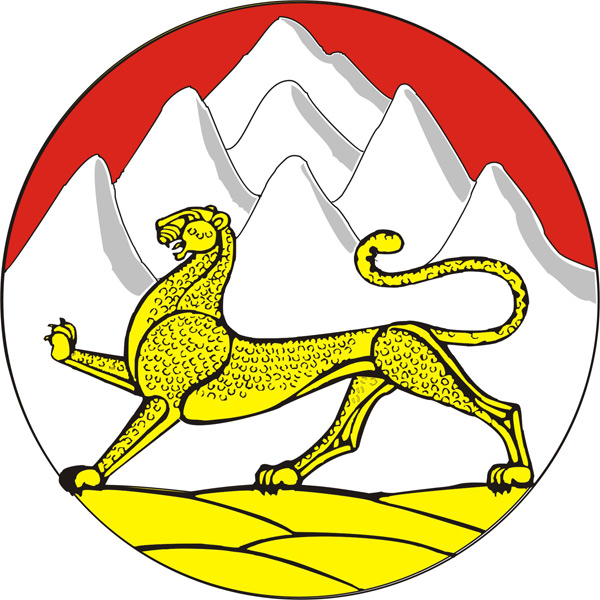 |
Wappen der Republik Nordossetien–Alanien – coat of arms of the Republic of North Ossetia–Alania, Quelle/Source: Russiatrek |
|
|
|
Landkarten – Maps: |
geographische Lage in Russland – geographical position within Russia: |
Landkarte des Landes – map of the country: |
|
|
Zahlen und Fakten – Numbers and Facts: |
|
|
|
|
|
|
|
|
|
|
|
|
|
|
|
|
|
|
|
|
|
|
|
|
|
Geschichte: |
| Antike ·
die Alanen siedeln im Nordkaukasus 370 · die Alanen werden von den Hunnen unterworfen, ein Teil der Alanen flieht vor den Hunnen (Völkerwanderung) über halb Europa bis auf die Iberische Halbinsel (Jahre 420-429), Teile kommen bis nach Afrika 520 · Christianisierung 1223 · Einfall der Mongolen in den Nordkaukasus, Vertreibung der Alanen nach Ungarn, Reste bleiben zurück und formieren sich als Osseten neu ca. 1780 · russische Eroberung 1784 Gründung von Wladikawkas, Bildung des Gouvernements Wladikawkas 1921 · Errichtung der Sowjetdiktatur 1921 · Errichtung der Sowjetdiktatur, das Land wird Teil der Sowjetischen Gebirgsrepublik innerhalb Sowjetrusslands 07.07.1924 · Errichtung des Nordossetischen Autonomen Bezirks 05.12.1936 · der Nordossetische Autonome Bezirk wird aufgehoben, Gründung der Nordossetischen Autonomen Sozialistischen Sowjetrepublik 1943–1944 · Deportation eines Teils der Osseten nach Sibirien 1957 · Rückkehr der Überlebenden 20.06.1990 · Nordossetien erklärt sich selbst zur Sozialistischen Autonomen Sowjetrepublik innerhalb der Sowjetunion 26.12.1990 · Nordossetien erklärt sich selbst zur Sozialistischen Sowjetrepublik innerhalb der Sowjetunion 31.12.1991 · die Sowjetunion löst sich auf, die Verfassung der Russischen Sozialistischen Föderativen Sowjetrepublik (RSFSR, Russland), ein ehemaliger Teilstaat der Sowjetunion bleibt vorerst in Kraft 1992 · Proklamation der Republik Nordossetien 25.12.1993 · eine neue Verfassung für Russland (Russische Föderation) tritt in Kraft, das Verhältnis zu den Gliedern der Föderation wird damit neu geregelt 1994 · Umbenennung in Republik Nordossetien–Alanien |
|
|
History: |
| antiquity ·
the Alanes settle in the Northern Caucasus 370 · the Alanes become subjected by the Huns, a part of the Alanes flees from the Huns (Great Transmigration, "Migration Period") over half Europe to the Iberian Peninsula (years 420-429), parts come to Africa 520 · christianization 1223 · invasion of the Mongols in the Northern Caucasus, expulsion of the Alanes to Hungary, leftovers stay and form up new as Ossetes ca. 1780 · conquest by Russia 1784 · foundation of Wladikawkas, formation of the Government of Wladikawkas 1921 · establishment of the soviet dictatorship, the country becomes a part of the Soviet Mountains Republic within Soviet Russia 7th of July 1924 · establishment of the North Ossetian Autonomous District 5th of December 1936 · the North Ossetian Autonomous District becomes dissoluted, establishment of the North Ossetian Autonomous Socialistic Soviet Republic 1943–1944 · deportation of a part of the Ossetes to Sibiria 1957 · return of the survivors 20th of June in 1990 · North Ossetia declared itself the Socialistic Autonomous Soviet Republic of the Soviet Union 26th of December in 1990 · North Ossetia declared itself the Socialistic Soviet Republic of the Soviet Union 31st of December in 1991 · the Soviet Union dissolves, the constitution of the Russian Socialist Federative Soviet Republic (RSFSR, Russia), a former substate of the Soviet Union, remains in force for the time being 1992 · proclamation of the Republic of North Ossetia 25th of December in 1993 · a new constitution for Russia (Russian Federation) comes into force, and the relationships with the members of the federation is re-regulated in this way 1994 · renamed in Republic of North Ossetia–Alania |
| Quelle/Source: Atlas zur Geschichte, World Statesmen, Russiatrek, Die Völker der Erde |
|
|
Ursprung des Landesnamens – Origin of the Country's Name: |
|
| Der Name "Ossetien" geht auf die Osseten zurück, ein iranisches Volk dessen Wurzel bis zu den Alanen zurückreicht. Die Osseten, die eigentlich "Ossen" heißen, nennen sich selbst "Iron" oder "Digoron". | The name
"Ossetia" comes from the Ossetes, an Iranian nation its roots reach back to
the Alanes. The Ossetes which are really designated "Ossen", name itself
"Iron" or "Digoron". |
| Quelle/Source: Die Völker der Erde | |
|
|
|